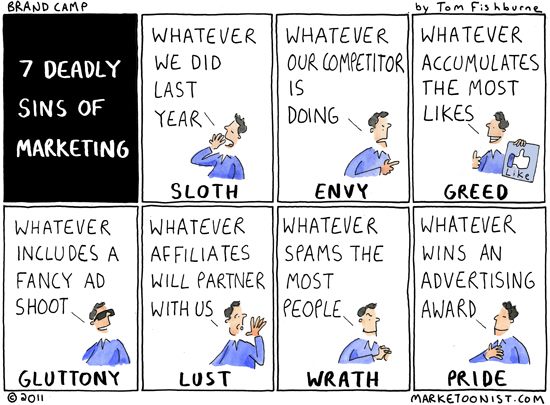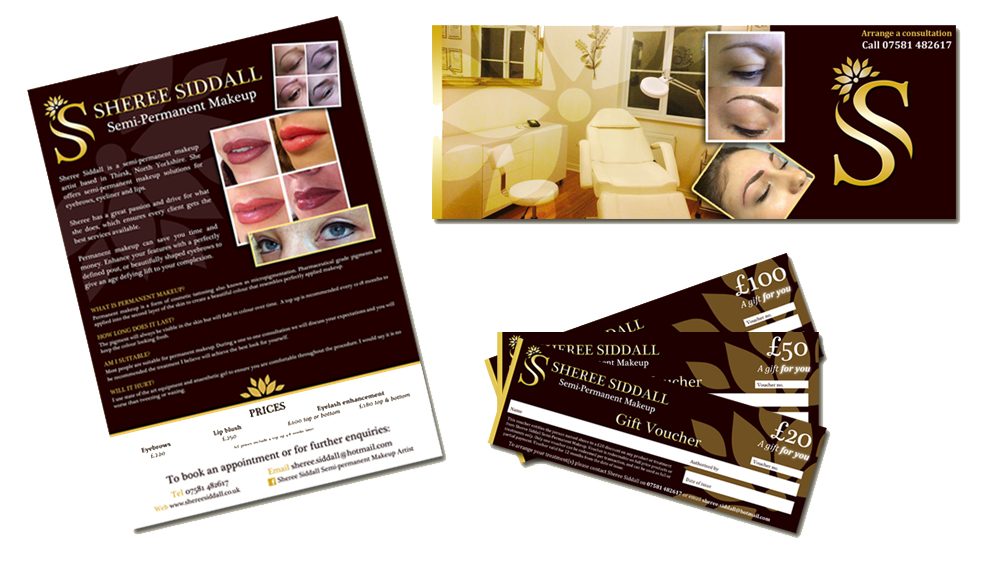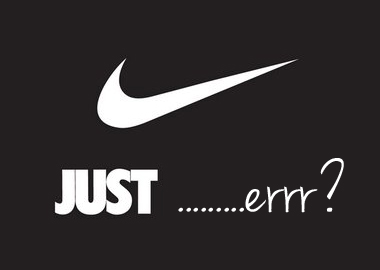
I recently came across the above cartoon on the web outlining the ‘7 deadly sins of marketing’. I found it amusing, but also felt it made a serious point about some of the traps businesses can fall into when making decisions about their marketing. Below is a short explanation of each of the ‘deadly sins’ and a few tips on how to avoid them.
1. SLOTH
“Do whatever we did last year”
Don’t automatically assume that just because a particular marketing method has worked well in the past that it will always be effective. People change, technology develops and competition shifts. So make sure you bear this in mind and review your marketing strategy on a regular basis; I’d suggest at least twice a year.
2. ENVY
“Do whatever our competitor is doing”
It’s ever so tempting to look over the fence at what everyone else is doing and assume you should be doing the same or very similar. But remember that you may have a completely different strategy and goal to them. A difference in objectives, target audience and USP may mean that the marketing methods a competitor uses makes perfect sense for them (but then it may not, remember they may not have the foggiest clue) but for you to do the same might in fact be bonkers!
3. GREED
“Do whatever accumulates the most Likes…”
…or Follows, depending on whether you’re a Twitter Tony or a Facebook Freddie. Please bear in mind that just because you get somebody to like your Facebook page, that doesn’t necessarily mean they are compelled to buy from you. Social Media can be great in terms of getting your name out, keeping in touch with past and present customers and is a beautifully compliment to word-of-mouth marketing strategies, but rarely should it be relied on as a standalone method to bring masses of sales.
4. GLUTTONY
“Do whatever includes a fancy ad shoot”
Of course it’s always nice to have sleek, shiny and professional-looking marketing material, and it certainly can be worth investing in this as image counts for a lot and it’s important to look the part regardless of the industry you are in. But don’t forget to think through your marketing expenditure and potential return-on-investment on certain options before making any decisions, otherwise you may be left with major cash flow issues and end up plummeting back down to earth with a bump!
5. LUST
“Do whatever will make affiliates partner with us”
Everybody wants themselves and their business to be liked, and in most cases it is crucial to build up a strong network of other businesses who you can collaborate with and partner with on particular projects. But don’t try and do this at the expense of jeopardising the core values and objectives of your own business. Be careful about those you decude to have any influence over you and your business. Choose wisely and don’t be afraid to say no to an opportunity if you feel uneasy or aren’t convinced it makes sense; chances are that you’re right.
6. WRATH
“Do whatever spams the most people”
Whether it’s by email, phonecall or social media, spamming people with your product or service is unlikely to make you many friends. The ‘spray and pray’ approach to marketing has been used for far too long. Instead, try being strategic about those you target and then invest your time into building relationships with those likely to buy from you. You’ll vastly reduce the amount of your marketing budget wasted, and those you choose to specifically target will appreciate the special treatment you give to them, so upping the chances of them doing business with you.
7. PRIDE
“Do whatever wins an advertising award”
With any decisions you make about your marketing strategy, do it against the backdrop of the objectives you have set for your marketing. Is the aim of your marketing to make you feel good about yourself by winning awards? If so then by all means go for it. But if, as with most of us, the aim of your marketing is to increase sales and grow your business, then make sure you keep this as the main goal, and resist letting your pride and desire for global recognition distract you. If you are doing a good job and going the extra mile in your business then there is no doubt you will gain recognition for that in lots of ways. A simple thank you card from a happy client on the mantlepiece is of far greater worth than an awards trophy.
Thanks for reading, and I hope you find some of what I’ve said helpful. If you feel you could do with some assistance formulating your own marketing strategy or putting it into practice, Back Room SAM offers an affordable 2-3 hour marketing strategy session structured specifically for small business owners. Please do get in touch for more information. I would love to hear from you and see what I can do to help.

www.backroomsam.co.uk
 How many Christmas newsletters have landed in your inbox so far this year? The festive season not only provides an ideal opportunity for businesses to get in touch with their contacts to wish them well, but a Christmas e-newsletter can also work as an effective marketing tool.
How many Christmas newsletters have landed in your inbox so far this year? The festive season not only provides an ideal opportunity for businesses to get in touch with their contacts to wish them well, but a Christmas e-newsletter can also work as an effective marketing tool.![]()









